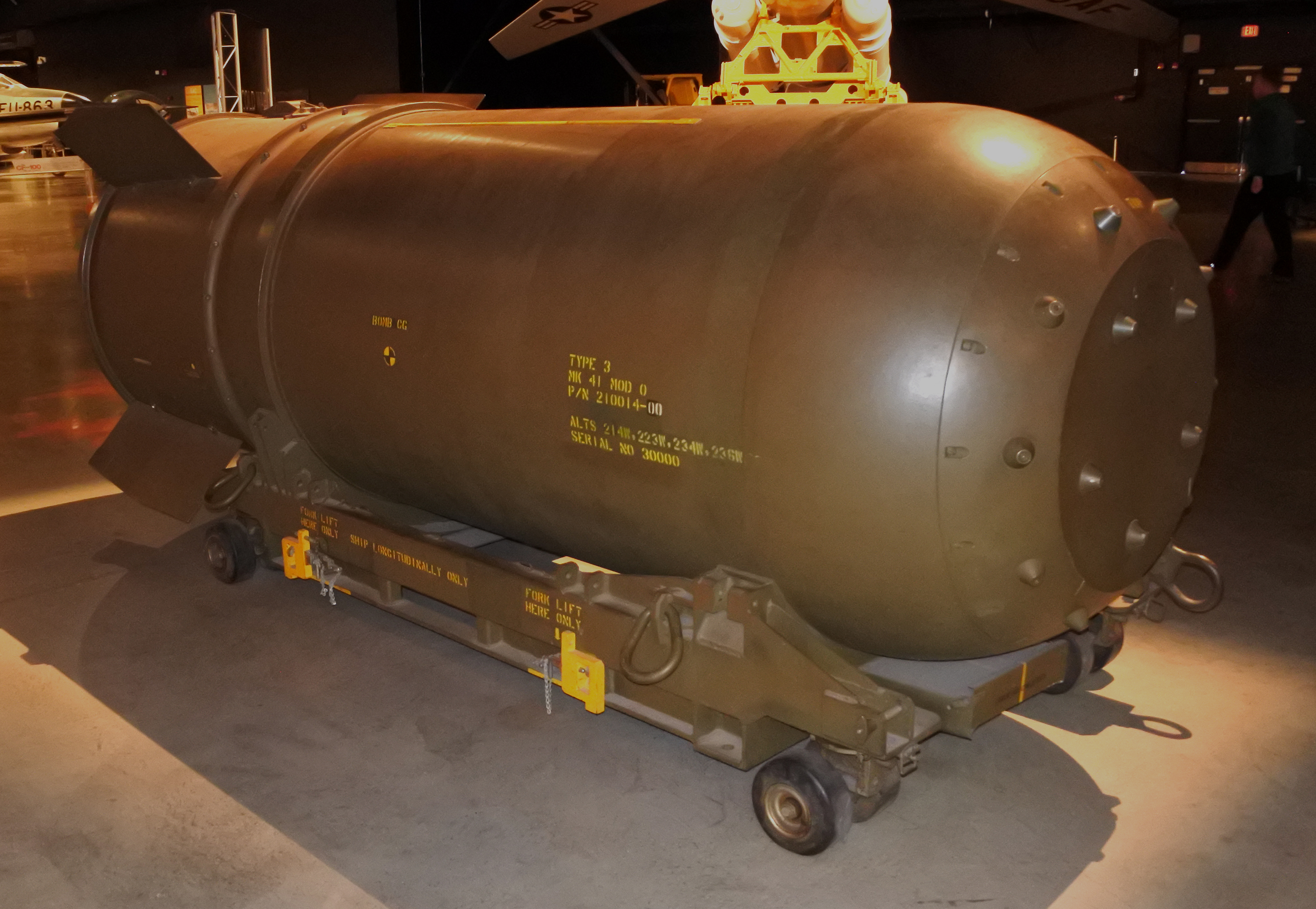|
B41 Nuclear Bomb
The B-41 (also known as Mk-41) was a thermonuclear weapon deployed by the United States Strategic Air Command in the early 1960s. It was the most powerful nuclear bomb ever developed by the United States, with a maximum yield of . A top secret document (DCI Briefing to the JCS, 1963), states “The US has stockpiled bombs of 9 MT and 23 MT...” which would likely be referring to the actual yield(s). The B-41 was the only three-stage thermonuclear weapon fielded by the U.S.The B-41 (Mk-41) Bomb Nuclear Weapon Archive. (accessed April 8, 2015). History  In June 1955, the
In June 1955, the
|
Mark 41 Thermonuclear Bomb Casing
Mark may refer to: In the Bible * Mark the Evangelist (5–68), traditionally ascribed author of the Gospel of Mark * Gospel of Mark, one of the four canonical gospels and one of the three synoptic gospels Currencies * Mark (currency), a currency or unit of account in many nations * Bosnia and Herzegovina convertible mark, the currency of Bosnia and Herzegovina * East German mark, the currency of the German Democratic Republic * Estonian mark, the currency of Estonia between 1918 and 1928 * Finnish markka (), the currency of Finland from 1860 until 28 February 2002 * Polish mark (), the currency of the Kingdom of Poland and of the Republic of Poland between 1917 and 1924 German * Deutsche Mark, the official currency of West Germany from 1948 until 1990 and later the unified Germany from 1990 until 2002 * German gold mark, the currency used in the German Empire from 1873 to 1914 * German Papiermark, the German currency from 4 August 1914 * German rentenmark, a currency issued on 1 ... [...More Info...] [...Related Items...] OR: [Wikipedia] [Google] [Baidu] |
Operation Plumbbob
Operation Plumbbob was a series of nuclear tests that were conducted between May 28 and October 7, 1957, at the Nevada Test Site, following ''Project 57'', and preceding '' Project 58/58A''. Background The operation consisted of 29 explosions, of which only two did not produce any nuclear yield. Twenty-one laboratories and government agencies were involved. While most ''Operation Plumbbob'' tests contributed to the development of warheads for intercontinental and intermediate range missiles, they also tested air defense and anti-submarine warheads with smaller yields. They included 43 military effects tests on civil and military structures, radiation and bio-medical studies, and aircraft structural tests. ''Operation Plumbbob'' had the tallest tower tests to date in the U.S. nuclear testing program as well as high-altitude balloon tests. One nuclear test involved the largest troop maneuver ever associated with U.S. nuclear testing. Approximately 18,000 members of the U.S. Ai ... [...More Info...] [...Related Items...] OR: [Wikipedia] [Google] [Baidu] |
Cold War Aerial Bombs Of The United States
Cold is the presence of low temperature, especially in the atmosphere. In common usage, cold is often a subjective perception. A lower bound to temperature is absolute zero, defined as 0.00K on the Kelvin scale, an absolute thermodynamic temperature scale. This corresponds to on the Celsius scale, on the Fahrenheit scale, and on the Rankine scale. Since temperature relates to the thermal energy held by an object or a sample of matter, which is the kinetic energy of the random motion of the particle constituents of matter, an object will have less thermal energy when it is colder and more when it is hotter. If it were possible to cool a system to absolute zero, all motion of the particles in a sample of matter would cease and they would be at complete rest in the classical sense. The object could be described as having zero thermal energy. Microscopically in the description of quantum mechanics, however, matter still has zero-point energy even at absolute zero, be ... [...More Info...] [...Related Items...] OR: [Wikipedia] [Google] [Baidu] |
List Of Nuclear Weapons
This is a list of nuclear weapons listed according to country of origin, and then by type within the states. The United States, Russia, China and India are known to possess a nuclear triad, being capable to deliver nuclear weapons by land, sea and air. United States American nuclear weapons of all types – bombs, warheads, shells, and others – are numbered in the same sequence starting with the Mark 1 and () ending with the W91 (which was cancelled prior to introduction into service). All designs which were formally intended to be weapons at some point received a number designation. Pure test units which were experiments (and not intended to be weapons) are not numbered in this sequence. Early weapons were very large and could only be used as free fall bombs. These were known by "Mark" designators, like the Mark 4 which was a development of the Fat Man weapon. As weapons became more sophisticated they also became much smaller and lighter, allowing them to be used in many ... [...More Info...] [...Related Items...] OR: [Wikipedia] [Google] [Baidu] |
Nuclear-warhead
A nuclear weapon is an explosive device that derives its destructive force from nuclear reactions, either nuclear fission, fission (fission or atomic bomb) or a combination of fission and nuclear fusion, fusion reactions (thermonuclear weapon), producing a nuclear explosion. Both bomb types release large quantities of energy from relatively small amounts of matter. Nuclear bombs have had Nuclear weapon yield, yields between 10 tons (the W54) and 50 megatons for the Tsar Bomba (see TNT equivalent). Yields in the low kilotons can devastate cities. A thermonuclear weapon weighing as little as can release energy equal to more than 1.2 megatons of TNT (5.0 Petajoule, PJ). Apart from the blast, Effects of nuclear explosions, effects of nuclear weapons include Firestorm, firestorms, extreme Thermal radiation, heat and ionizing radiation, radioactive nuclear fallout, an Nuclear electromagnetic pulse, electromagnetic pulse, and a radar blackout. The first nuclear weapons were deve ... [...More Info...] [...Related Items...] OR: [Wikipedia] [Google] [Baidu] |
Nuclear Weapon Yield
The explosive yield of a nuclear weapon is the amount of energy released such as blast, thermal, and nuclear radiation, when that particular nuclear weapon is detonated. It is usually expressed as a ''TNT equivalent'', the standardized equivalent mass of trinitrotoluene (TNT) which would produce the same energy discharge if detonated, either in kilotonnes (symbol kt, thousands of tonnes of TNT), in megatonnes (Mt, millions of tonnes of TNT). It is also sometimes expressed in terajoules (TJ); an explosive yield of one terajoule is equal to . Because the accuracy of any measurement of the energy released by TNT has always been problematic, the conventional definition is that one kilotonne of TNT is held simply to be equivalent to 1012 calories. The yield-to-weight ratio is the amount of weapon yield compared to the mass of the weapon. The practical maximum yield-to-weight ratio for fusion weapons (thermonuclear weapons) has been estimated to six megatonnes of TNT per tonne of bomb ... [...More Info...] [...Related Items...] OR: [Wikipedia] [Google] [Baidu] |
Tsar Bomba
The Tsar Bomba (code name: ''Ivan'' or ''Vanya''), also known by the alphanumerical designation "AN602", was a Thermonuclear weapon, thermonuclear aerial bomb, and by far the most powerful nuclear weapon ever created and tested. The Soviet physicist Andrei Sakharov oversaw the project at Arzamas-16, while the main work of design was by Sakharov, Viktor Adamsky, Yuri Babayev, , and Yuri Trutnev (scientist), Yuri Trutnev. The project was ordered by General Secretary of the Communist Party, First Secretary of the Communist Party Nikita Khrushchev in July 1961 as part of the Soviet resumption of nuclear testing after the Partial Nuclear Test Ban Treaty#Khrushchev and a moratorium: 1958–1961, Test Ban Moratorium, with the detonation timed to coincide with the 22nd Congress of the Communist Party of the Soviet Union (CPSU). Tested on 30 October 1961, the test verified new design principles for high-yield thermonuclear charges, allowing, as its final report put it, the design o ... [...More Info...] [...Related Items...] OR: [Wikipedia] [Google] [Baidu] |
Natural Uranium
Natural uranium (NU or Unat) is uranium with the same isotopic ratio as found in nature. It contains 0.711% uranium-235, 99.284% uranium-238, and a trace of uranium-234 by weight (0.0055%). Approximately 2.2% of its radioactivity comes from uranium-235, 48.6% from uranium-238, and 49.2% from uranium-234. Natural uranium can be used to fuel both low- and high-power nuclear reactors. Historically, graphite-moderated reactors and heavy water-moderated reactors have been fueled with natural uranium in the pure metal (U) or uranium dioxide (UO2) ceramic forms. However, experimental fuelings with uranium trioxide (UO3) and triuranium octaoxide (U3O8) have shown promise. The 0.72% uranium-235 is not sufficient to produce a self-sustaining critical chain reaction in light water reactors or nuclear weapons; these applications must use enriched uranium. Nuclear weapons take a concentration of 90% uranium-235, and light water reactors require a concentration of roughly 3% uranium-235 ... [...More Info...] [...Related Items...] OR: [Wikipedia] [Google] [Baidu] |
Uranium-238
Uranium-238 ( or U-238) is the most common isotope of uranium found in nature, with a relative abundance of 99%. Unlike uranium-235, it is non-fissile, which means it cannot sustain a chain reaction in a thermal-neutron reactor. However, it is fissionable by fast neutrons, and is ''fertile'', meaning it can be transmuted to fissile plutonium-239. 238U cannot support a chain reaction because inelastic scattering reduces neutron energy below the range where fast fission of one or more next-generation nuclei is probable. Doppler broadening of 238U's neutron absorption resonances, increasing absorption as fuel temperature increases, is also an essential negative feedback mechanism for reactor control. Around 99.284% of natural uranium's mass is uranium-238, which has a half-life of 1.41 seconds (4.468 years, or 4.468 billion years). Due to its natural abundance and half-life relative to other radioactive elements, 238U produces ~40% of the radioactive heat produced wit ... [...More Info...] [...Related Items...] OR: [Wikipedia] [Google] [Baidu] |
B-47 Stratojet
The Boeing B-47 Stratojet (Boeing company designation Model 450) is a retired American long- range, six-engined, turbojet-powered strategic bomber designed to fly at high subsonic speed and at high altitude to avoid enemy interceptor aircraft. The primary mission of the B-47 was as a nuclear bomber capable of striking targets within the Soviet Union. Development of the B-47 can be traced back to a requirement expressed by the United States Army Air Forces (USAAF) in 1943 for a reconnaissance bomber that harnessed newly-developed jet propulsion. Another key innovation adopted during the development process was the swept wing, drawing upon captured German research. With its engines carried in nacelles underneath the wing, the B-47 represented a major innovation in post–World War II combat jet design, and contributed to the development of modern jet airliners. In April 1946, the USAAF ordered two prototypes, designated "XB-47. On 17 December 1947, the first prototype perfor ... [...More Info...] [...Related Items...] OR: [Wikipedia] [Google] [Baidu] |
B-52 Stratofortress
The Boeing B-52 Stratofortress is an American long-range, subsonic aircraft, subsonic, jet-powered strategic bomber. The B-52 was designed and built by Boeing, which has continued to provide support and upgrades. It has been operated by the United States Air Force (USAF) since 1955 and was flown by NASA from 1959 to 2007. The bomber can carry up to of weapons and has a typical Range (aeronautics), combat range of around without aerial refueling. After Boeing won the initial contract in June 1946, the aircraft's design evolved from a straight wing, straight-wing aircraft powered by six turboprop engines to the final prototype YB-52 with eight turbojet engines and swept wings. The B-52 took its maiden flight in April 1952. Built to carry nuclear weapons for Cold War Nuclear strategy, deterrence missions, the B-52 Stratofortress replaced the Convair B-36 Peacemaker. The bombers flew under the Strategic Air Command (SAC) until it was disestablished in 1992 and its aircraft abso ... [...More Info...] [...Related Items...] OR: [Wikipedia] [Google] [Baidu] |
B41 Nuclear Bomb
The B-41 (also known as Mk-41) was a thermonuclear weapon deployed by the United States Strategic Air Command in the early 1960s. It was the most powerful nuclear bomb ever developed by the United States, with a maximum yield of . A top secret document (DCI Briefing to the JCS, 1963), states “The US has stockpiled bombs of 9 MT and 23 MT...” which would likely be referring to the actual yield(s). The B-41 was the only three-stage thermonuclear weapon fielded by the U.S.The B-41 (Mk-41) Bomb Nuclear Weapon Archive. (accessed April 8, 2015). History  In June 1955, the
In June 1955, the
|








